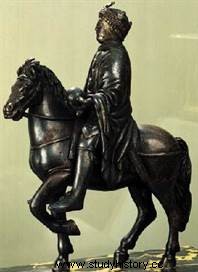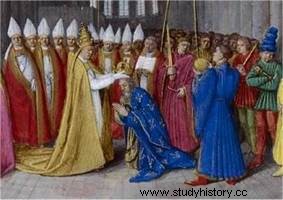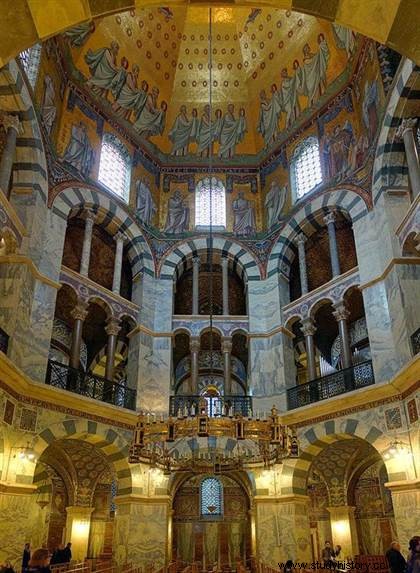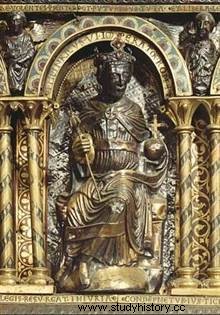 Charlemagne (742-814) is a Frankish king then an Emperor of the West who reigned from 768 to 814 and gave his name to the Carolingian dynasty. Eldest son of Pepin the Short, he reigned alone after the death of his brother Carloman in 771 over an area which then covered Gaul and part of Germania. In 774, he proclaimed himself king of the Lombards and began his policy of expansion, leading numerous military campaigns. In 46 years of reign, he made the Frankish kingdom the largest territory since the fall of the Roman Empire. Supported by the papacy, because he imposed Christianity on the conquered peoples, Charlemagne was crowned emperor of the West on Christmas Day 800. Called "the emperor with the flowery beard", he is known thanks to the description given by the chronicler Einhard, who wrote the Life of Charlemagne around 830 .
Charlemagne (742-814) is a Frankish king then an Emperor of the West who reigned from 768 to 814 and gave his name to the Carolingian dynasty. Eldest son of Pepin the Short, he reigned alone after the death of his brother Carloman in 771 over an area which then covered Gaul and part of Germania. In 774, he proclaimed himself king of the Lombards and began his policy of expansion, leading numerous military campaigns. In 46 years of reign, he made the Frankish kingdom the largest territory since the fall of the Roman Empire. Supported by the papacy, because he imposed Christianity on the conquered peoples, Charlemagne was crowned emperor of the West on Christmas Day 800. Called "the emperor with the flowery beard", he is known thanks to the description given by the chronicler Einhard, who wrote the Life of Charlemagne around 830 .
Charles' youth
The precise date of Charlemagne's birth is controversial. The commonly accepted date is April 2, 742 and is based on the account of Einhard, abbot and intellectual of the ninth century. The place of birth is not mentioned, however. Several historians place his birth in Austrasia , the northeast of present-day France. Son of Pépin Le Bref and Berthe au grand pied , the birth of Charles would have been illegitimate. Indeed, his parents would have married religiously between 743 and 744, more than a year after his birth. All this contributes to the dispute between historians on the exact date and place of his birth.
 He was baptized in 754 by Pope Stephen III who came to visit his father. In his youth, young Charles did not learn to write. He will make up for this deficiency in adulthood. However, he can read and knows a little Latin. But the sources which evoke his childhood and his youth are only too rare, even non-existent, to paint an exact portrait of little Charles. We know, however, that he was very attached to his sister, the extravagant Ghisla , a little younger than him. A childhood that, for the most part, remains mysterious.
He was baptized in 754 by Pope Stephen III who came to visit his father. In his youth, young Charles did not learn to write. He will make up for this deficiency in adulthood. However, he can read and knows a little Latin. But the sources which evoke his childhood and his youth are only too rare, even non-existent, to paint an exact portrait of little Charles. We know, however, that he was very attached to his sister, the extravagant Ghisla , a little younger than him. A childhood that, for the most part, remains mysterious.
The wives of Charlemagne
Officially, Charlemagne had six wives. Unofficially, he had multiple adventures. Physically, his biographer Einhard describes him thus “Broad and robust, he was tall, without anything excessive, for he was seven feet high (1m90). He had a rounded top of his head, large lively eyes, a nose a little longer than average, fine white hair, a cheerful and open countenance. We didn't even notice that his neck was fat and too short and his belly too protruding. He had a confident gait, a manly bearing. The voice was clear, but not entirely suited to his physique. . The man apparently benefits from an advantageous physique and an impressive stature, especially for the time when the man was on average 1m67 tall.
His first marriage dates from 768 . He marries Himiltrude , daughter of a Count of Burgundy. Two years and two children later, he abandoned her and took Désirée as his wife. , daughter of the King of the Lombards, Didier. This marriage, above all political, was quickly cut short under the pretext of sterility. Charlemagne, then in his thirties, married a young girl of thirteen, Hildegarde . Nine children later, she died in 783 of a miscarriage. To console himself and two months later, Charlemagne took Fastrade as his wife. who will give him two daughters. This one died in 794, she was immediately replaced by Liutgarde , eighteen years old and daughter of the Count of Alsace. She died in 800 and eight years later, our Carolingian Dom Juan entered into cohabitation with Gerswinde , daughter of the King of the Saxons. She gives him a daughter at the age of sixty-six. Alongside his official wives, Charlemagne had many adventures, notably with his sister Ghisla around 771. She would even have become pregnant. Out of shame and dishonour, Charlemagne hastens to find her a husband, Roland, and at the same time enacts a capitular prohibiting incest. Charlemagne will have had seventeen children in total.
All these unions are not without meaning. Charlemagne does not choose his wives by chance. These are above all political choices aimed at gaining the confidence of his enemies. Thus he himself will say "I alone have the duty and the right to take a wife." In a family like ours, marriage should only serve to conclude alliances, pay debts, or ensure an heir to the throne (…)”.
Carolus magnus, a well-supported monarch
A closer look at the sources reveals that little is known about Charles' personal life. The only companions that we really know of him are his brothers in arms with whom he goes on campaign. One of his most famous associates is none other than Roland (736-778) called the brave . Nephew of Charlemagne, Roland is a Frankish knight who left his name to the famous Roland song . Count of the March of Brittany, he is also very close to his uncle. During the Battle of Roncesvalles (778) where he perishes, while Charles' army retreats, Roland and his soldiers find themselves ambushed between two cliffs. The latter then handles his Durandal sword and gives battle. Quickly outnumbered, he blows into his olifant to call for help from his friend Charles. The latter will arrive too late. When he sees the remains of his nephew, he hugs her tightly and would have expressed himself thus “There will never be a day that I will not suffer thinking of you.
 To manage his vast estate from his palace in Aachen , Charles installed throughout the empire "counts", from the aristocracy or confirmed warriors. At the head of homogeneous regions, the latter are responsible for administering their territory in the name of the rex , whether to maintain order, dispense justice or levy taxes. The distances helping, the counts quickly take too many liberties. To assert his authority, Charles resorted to the "missi dominici ". These "messengers of the master", a cleric and a layman, tirelessly travel the kingdom to inform royal decisions and ensure their application. The system will quickly turn from its initial objective and will become the basis of the feudal system .
To manage his vast estate from his palace in Aachen , Charles installed throughout the empire "counts", from the aristocracy or confirmed warriors. At the head of homogeneous regions, the latter are responsible for administering their territory in the name of the rex , whether to maintain order, dispense justice or levy taxes. The distances helping, the counts quickly take too many liberties. To assert his authority, Charles resorted to the "missi dominici ". These "messengers of the master", a cleric and a layman, tirelessly travel the kingdom to inform royal decisions and ensure their application. The system will quickly turn from its initial objective and will become the basis of the feudal system .
At court, many scholars came to see the Carolingian sovereign. Alcuin of York is a close adviser to the Emperor. He was the head of the greatest school of the empire, the Palatine Academy . Einhard will say of him that he is "the most learned man of his time" . Dungal of Bangor , Irish monk, is the official astronomer of Charlemagne. He is the precursor of what will develop seven hundred years later Nicolas Copernicus . Many other scholars jostled at court such as Einhard, Théodulf or Raban Maur, making the Carolingian Empire a place where men exchanged their knowledge.
Charles was close to his mother, Berthe au grand pied. She would even have intervened in the political affairs of her son. Thus, some write that Bertha would have pushed Charles to marry Désirée, daughter of the Lombard king, to conclude an alliance. For the record, their close relationship soured the day Carles called his mother “whore”. She would then have retorted to him “My son, do not mention my infidelities, it could come back to you in the face”.
Charlemagne, a man of war...
 His "political" life really began in 768, when his father Pépin Le Bref bequeaths his kingdom, recently enlarged by Aquitaine, to his two sons:Charles and Carloman. The two brothers do not like each other and fight over the kingdom. Finally Carloman died in 771, Charles became the sole head of the Frankish kingdom.
His "political" life really began in 768, when his father Pépin Le Bref bequeaths his kingdom, recently enlarged by Aquitaine, to his two sons:Charles and Carloman. The two brothers do not like each other and fight over the kingdom. Finally Carloman died in 771, Charles became the sole head of the Frankish kingdom.
In this second half of the 8th century, the Frankish kingdom is the only stable and viable state in Europe that emerged from the barbarian invasions and the fall of the Roman Empire . Visigothic Spain was annihilated by the Muslims, Italy is divided between Lombards and Byzantines, Central and Northern Europe fragmented into a multitude of barbarian kingdoms and nations with ill-defined contours. The kingdom of Charles is powerful but surrounded on all sides.
Already strongly tinged with feudalism, Frankish society is organized in a pyramidal and clientelist fashion. The lords, landowners, attach themselves to their service of free men, their vassals, who in exchange for their armed wing are offered lodging, food, and many gifts, which is expensive. However, the economic context of the time was not very bright. The industry has disappeared from the cities to take refuge in the countryside, around farms erected in villas on the Roman model, and which operate in quasi autarky. It has been a long time since the Roman peace no longer ensured the security of commercial exchanges, and money was scarce . The land being the only wealth of the time, there is no other choice to maintain the system than to go and take that of the neighbor.
As early as 772, Charles undertook his first expeditions to the Saxons, which he ended up subduing, not without difficulty, definitively in 804. In 785 he promulgated the Saxon capitulary which imposes baptism on the Saxons and punishes with death attachment to pagan rites. In 774, he seized Pavia and takes the crown of Didier, fallen king of the Lombards. Between 785 and 801, he captured Barcelona and conquers what historians call the Spanish March (present-day Catalonia). It was on his return from an expedition across the Pyrenees that Charles suffered a serious setback at Roncesvalles, his rearguard falling into an ambush set by Basques.
Charles' strength lies in the quality of his army and in the harshness, even the atrocity, with which he fights. Military service, the Ost, is compulsory in the kingdom. But the numbers are still relatively modest with 5,000 heavy cavalry, 36,000 light cavalry plus a number of infantry[9]. The army wins because it is well trained , his armored cavalry easily pierces the enemy ranks. The speed of maneuver and the pincer strategy ensure decisive successes in each campaign.
At his death, Charlemagne will have unified a territory that extends from Saxony in the North to Navarre or Rome in the South and from Aquitaine to the 'West to Carinthia (Austria) in the East . Some see him as the emperor who succeeded in rebuilding a "new Rome". In this regard, shortly after his coronation, Charlemagne had several seals inscribed with the formula Renovatio romani imperii, evidence of his desire to rebuild the Roman Empire.
... and a man of faith
 Throughout his reign, Charlemagne continued to propagate the Christian faith . All his conquests are accompanied by a conversion to Catholicism , mostly forced. The unity of faith is the true cement of the empire. In this vision of the "state", the emperor's mission is to lead his people to salvation. To do this, Charles intervenes on many occasions in the definition of dogma. In 794, during the Synod of Frankfurt, a deliberative assembly of ecclesiastics, he had a heresy spread in Spain condemned. He violently opposed the Council of Nicaea in 787 and entrusts Theodulf, a clergyman and scholar of the Carolingian era, with writing a controversial dossier, the Libri Carolini.
Throughout his reign, Charlemagne continued to propagate the Christian faith . All his conquests are accompanied by a conversion to Catholicism , mostly forced. The unity of faith is the true cement of the empire. In this vision of the "state", the emperor's mission is to lead his people to salvation. To do this, Charles intervenes on many occasions in the definition of dogma. In 794, during the Synod of Frankfurt, a deliberative assembly of ecclesiastics, he had a heresy spread in Spain condemned. He violently opposed the Council of Nicaea in 787 and entrusts Theodulf, a clergyman and scholar of the Carolingian era, with writing a controversial dossier, the Libri Carolini.
When Charlemagne seized territory, he immediately decreed capitulars aimed at converting the subjugated population. One of the most "famous" is the Saxon capitular who, in 785, imposed forced baptism on the Saxons and punished with death attachment to ancient pagan rites. This text, which imposes the law of the emperor, resembles the distant Code of Hammurabi on the form and is expressed in these terms:“whoever enters a church by violence (…) will be put to death. Anyone who kills a bishop (…) will be condemned to death. From now on, any unbaptized Saxon who seeks to hide among his compatriots and refuses to be baptized, wishing to remain a pagan, will be put to death (…). » .
The coronation of Charlemagne as Western Roman Emperor in the year 800 was above all made on religious ideological bases. When he expands his kingdom, he expands the Church of Christ. Charlemagne's vocation is to bring together all Western peoples in a single empire which is itself identified with the Church. It is therefore in this spirit that he let himself be crowned Emperor of the Romans, on December 25, 800 at Saint Peter's Basilica in Rome, by Pope Leo III.
A culture propagator

Settled in its new capital of Aachen , which had the advantage of occupying a central position in his Empire, as well as having game-rich forests, Charles attracted around him a number of intellectuals, artists and scholars, sometimes placing them in key positions:many Italians, the poet and historian Paul Deacon, the grammarian Pierre de Pisa, the Englishman Alcuin, the most erudite of his time, to whom he entrusted the schools of the capital. It encourages the spread of Latin , and the monasteries are filled with copyists and illuminators. This cultural and religious abundance, we then speak of "Carolingian renaissance », contributes significantly to the foundation of a Christian and Romanesque Europe.
For many, this sacred Charlemagne would be the inventor of the school . The Carolingian emperor did not "invent" the school per se, traces of which can be found up to the year 3000 BC in Egypt, but was the first sovereign to actually legislate on the setting in place of school executives . The most important text is the Admonitio Generalis written in 789. The text advocates advanced instruction of the clergy who in turn can provide education to the people, all in the Christian faith. The Admonito generates many schools and its teaching will constitute the basis of school and university culture throughout the Middle Ages through the practice of the seven liberal arts that it diffuses. One of the first objectives is to restore Latin in order to translate religious texts.
Thanks to the system that Charlemagne puts in place, the Christian faith can spread much more easily. The Carolingian emperor allowed the arts to develop, Greco-Latin culture to resurface, the scholars of Europe to exchange their cultures within the royal court in particular. This period of cultural revival would later be referred to as the "Carolingian Renaissance ".
Charlemagne, Father of Europe?
In fact a unified Europe, the Empire is made up of a myriad of disparate peoples, with no less different customs, laws and languages, which often have only one thing in common to be subject to the authority of the Emperor. His subjects had very little awareness at the time of being part of a homogeneous whole. They are, however, beginning to be referred to and identified as Europeans, as opposed to the "infidel" Muslims of the south and the Slavic pagans of the east.
Based in his new capital Aix-la-Chapelle, which has the advantage of occupying a central position in his Empire, as well as having game-rich forests, Charles attracts around him a number of intellectuals, artists and scholars, sometimes placing them in key positions:many Italians, the poet and historian Paul Deacon, the grammarian Pierre de Pisa, the Englishman Alcuin, the most erudite of his time, to whom he entrusts the schools of the capital. He encouraged the spread of Latin, and the monasteries were filled with copyists and illuminators. This cultural and religious proliferation, we then speak of the "Carolingian renaissance", contributes significantly to the foundation of a Christian and Romanesque Europe.
Was there a grand political plan on the part of the man who, during his lifetime, was referred to as "Pater Europae", father of Europe, as much as "Europa vel regnum Caroli", Europe, or the kingdom of Charles, or a very personal vision of his achievements? Charlemagne seems more concerned with ensuring his posterity than with perpetuating his work over time. As soon as he died, the Empire was divided between his sons and grandsons according to the ancient Frankish barbarian custom, and it quickly exploded into many States which went to war for nearly a thousand years.
The romantic ideal of a Christian Europe unified by Charlemagne is quite contemporary, magnified in particular in the 19th century by Victor Hugo and only remotely corresponds to the reality of the time . The fact remains that this short-lived Carolingian Empire, a veritable bridge between the ancient Roman and barbarian period and nascent medieval Europe, sowed the seeds of a political, cultural and religious heritage which most Europeans today can claim.
 It will have been understood that throughout his reign, which was extremely long, Charlemagne had no stop spreading the Christian faith throughout Western Europe. If some consider him today as "father of Europe », one can think that he himself never thought in this way. On the political and spiritual level, two main concerns animated him:to rebuild the Roman Empire and to spread the Christian faith. On a personal level, Charles will have marked his time thanks to the importance he was able to give to his kingdom. At his death on January 28, 814 , his son Louis the Pious who succeeds him will not be able to prevent the dislocation of the Carolingian empire.
It will have been understood that throughout his reign, which was extremely long, Charlemagne had no stop spreading the Christian faith throughout Western Europe. If some consider him today as "father of Europe », one can think that he himself never thought in this way. On the political and spiritual level, two main concerns animated him:to rebuild the Roman Empire and to spread the Christian faith. On a personal level, Charles will have marked his time thanks to the importance he was able to give to his kingdom. At his death on January 28, 814 , his son Louis the Pious who succeeds him will not be able to prevent the dislocation of the Carolingian empire.
Life of Charlemagne, the oldest biography of the emperor
Written in Latin around 830 or 836 by the Frankish historian Einhard, the Vita Caroli Magni is largely inspired by the Life of the Twelve Caesars by Suetonius, and in particular the chapter devoted to the life of Augustus. Tracing the structure of the Latin work, Einhard's account begins when the Carolingians become mayors of the palace before recounting the reign of Charlemagne itself.
The Carolingian conquests, including the famous battle of Roncesvalles during which Roland perished, are amply detailed. A description of the newly founded empire, of its internal government, of the diplomatic relations that Charlemagne developed with neighboring sovereigns, provides precise information on the history of this reign. More precious still, Einhard, in the service of the emperor during the last twenty years of his reign, approached Charlemagne enough to paint a portrait of him:a "broad and robust" man, Charlemagne was described as an extremely pious man, protector of the arts and letters, of a great intellectual curiosity, which pushed him to learn Latin.
At a time of succession turmoil, Einhard's goal is to magnify the imperial reign of Charlemagne. This panegyric thus uses many qualifiers to present the sovereign:virtuous king, wise, courageous and shrewd strategist, Charlemagne offers the features of a governmental model. A work copied many times in the scriptoria, as evidenced by the numerous manuscripts preserved to this day, the Vita Caroli Magni had a great echo among Einhard's contemporaries. The first printed edition of the Life of Charlemagne was produced in Cologne in 1521.
Bibliography
- By Georges Minois, Charlemagne, Editions Perrin, March 2010.
- From Jean Favier, Charlemagne. Fayard, 1999.
- From Georges Bordonove, Charlemagne:Emperor and King. Pygmalion, 2008.
